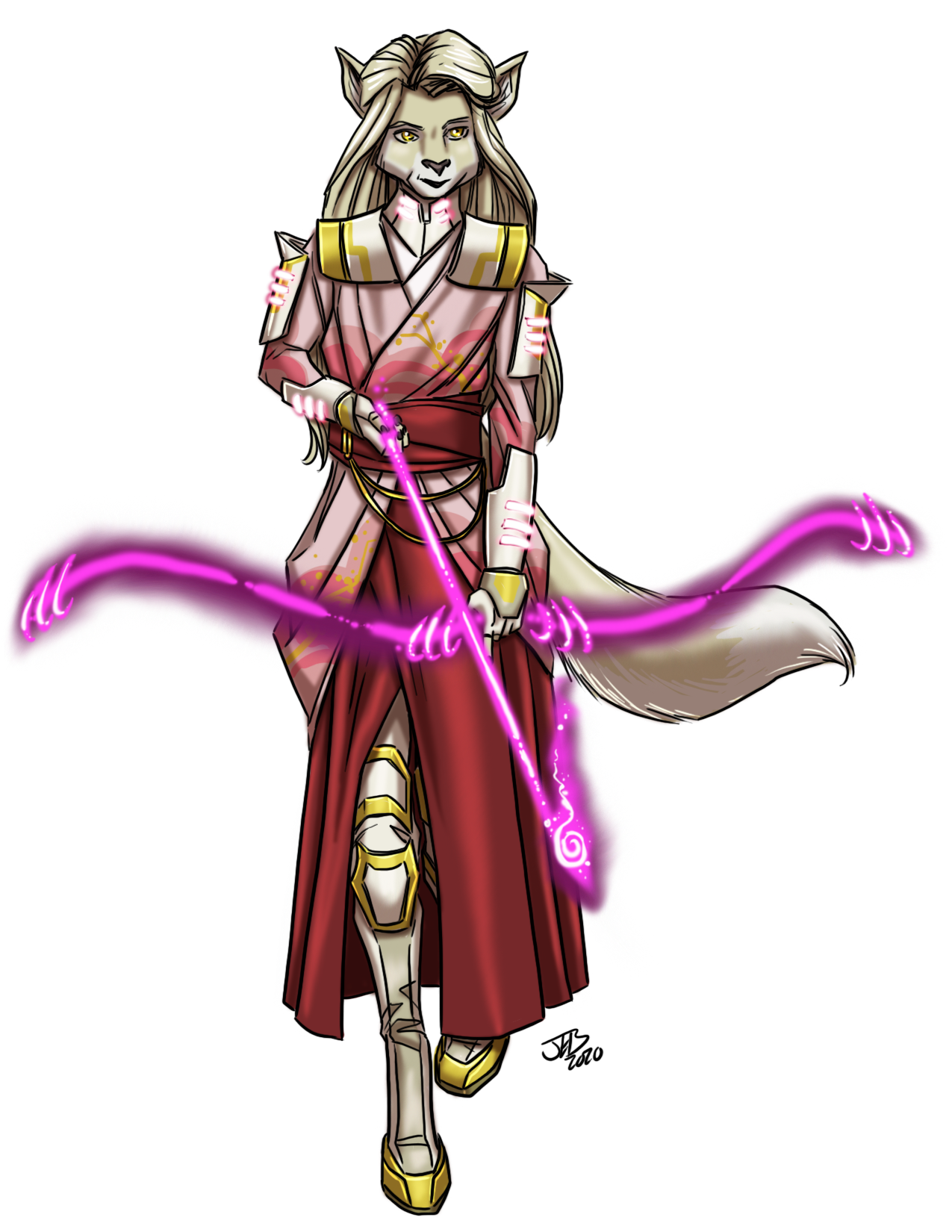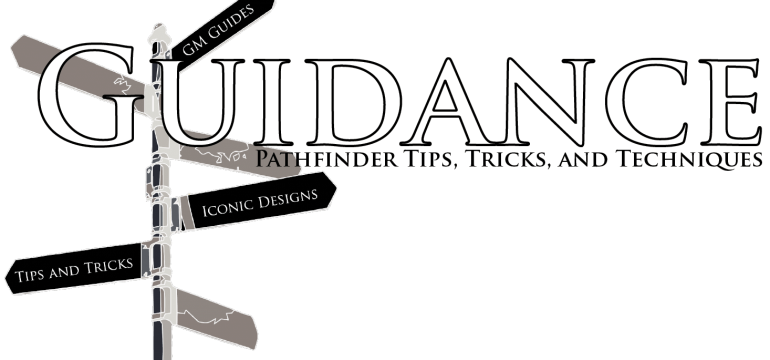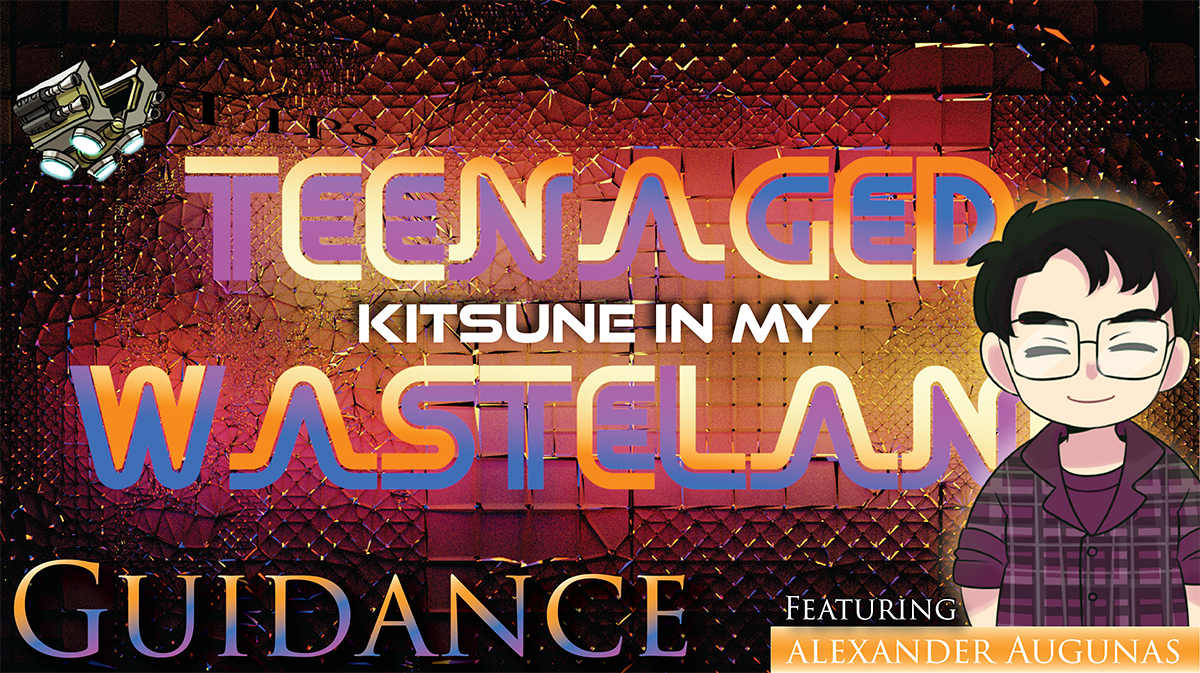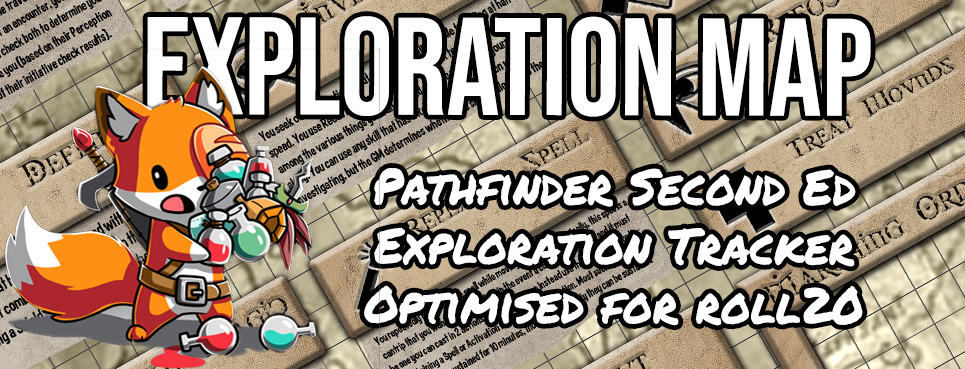Hello, readers, and welcome back to Guidance! Sometimes when I’m writing these articles, things go great and I write exactly what I want to write, when I want to write it. Othertimes I get myself into silly jokes with Paizo Developers and decide to completely change gears at the last possible second.

… today is one of those days. Inari help me….
What Are Kitsune?
It’s probably no surprise that kitsune exist in the Blood Space campaign system, and ergo in my Teenaged Wasteland campaign. After all, my company’s brand is literally kitsune and my personal brand as an author is literally kitsune. Years ago when the amazing Amanda Hamon got hired by Paizo, I bumped in to her at the PaizoCon ballroom while I was leaving; it was either the night of the PaizoCon banquet or I was leaving a Pathfinder Society Scenario, I can’t recall which. Anyway, I recognized her as a new hire and wanted to introduce myself to her. Everybody Games was young at the time, but after I said my introductions Amanda was like, “Oh, I recognize you. You’re the guy who only writes kitsune, right?”
… partial success.
Anyway, the point is that there were always going to be kitsune in Blood Space, and there have been since the first time I wrote about the Blood Space campaign setting, in the Starfarer’s Companion. Since Starfinder is an evolution of Pathfinder, kitsune in Blood Space are purposefully similar to those in Pathfinder. They’re humanoid foxes in their true forms and are able to use their natural shapeshifting to assume a human identity that’s unique to that individual and inherited from their parents. In a sense, a kitsune inherits genetic traits for their human form the same as they do their original form. This is very much a survival mechanism; if a baby kitsune looked too different from their parents or siblings while transformed, it could very well give the family away as something not human. This idea, that shapeshifting isn’t just a magical “poof I’m a human” thing and is very much a core part of their being is integral to the Blood Space campaign setting. Along the same lines:
- A kitsune’s human form maintains as many of the same physical traits as their original form as possible. For example, if a kitsune puts on 10 pounds in their original form, their human form’s going to chub out too. Similarly, a kitsune’s hair color and eye color don’t change between transformations, they’re roughly the same height and of the same build, and they can’t change the pigmentation or length of their hair. Individual kitsune with superior shapeshifting can buck these trends, of course, but generally speaking these are the limitations.
- One of the core ideas to the Blood Space setting is that kitsune can sire kids with anything humans can while in human form, but the resulting children are always kitsune themselves. A kitsune born to a pairing between a kitsune and a non-kitsune also has traits that strongly favor the non-kitsune parent; as a result, there are kitsune with human forms that resemble just about every human ethnic group imaginable.
- Kitsune can’t typically “repair” their bodies using their transformations. For example, if you lose a hand in your human form, that arm’s also gone in your true form. If their eye in kitsune form gets gouged out (more on that later), it remains gouged out when they change into a human. Again, kitsune with superior shapechanging can bypass this somewhat, but for most kitsune that’s not an option.
Kitsune Mythology in Blood Space
When you talk about kitsune, one of the first topics that comes up is the magical tails. Those exist in the Blood Space campaign setting, but they’re specifically very rare among the general population. That being said, a lot of the mythology surrounding kitsune hasn’t changed much across time; on Twitter, James joked about digital storage units that work like the old Star Balls from kitsune mythology, but with a digital twist. I … didn’t like that approach in Blood Space. Not because I don’t think things should improve as technology advances, far from it. But in the Starfinder RPG, where everything is very advanced and technologically derived, there’s a certain level of mysticism that exists when one chooses to remain with the traditional. In fact, it’s probably more special in a Starfinder setting, where high technology is the assumption than in, say, Pathfinder, where the star ball is just another magic item. It’s a stylistic choice that plays into the idea that for most kitsune, that type of magical item is very old, very sacred, and very traditional. It’s really easy to take technological trappings and just paint them onto everything in Starfinder, but knowing when to stop, look at a thing, and say, “No, this needs to stay mystical and occult,” allows you to develop a contrast that you can build an entire campaign around, similar to how the decision to actually have technology in Golarian’s Numeria and not, say, highly advanced magic items that replicate technology, is a strong decision that adds to that nation’s mystique.
So, how does the kitsune mythology work in Blood Space? As so!
- Kitsune star jewels exist, but they’re few and far between. Most of the original ones are relics from thousands of years ago and are highly prized. Some take the form of rechargable spell jewels, others are solarian crystals. No two star jewels are the same.
- Kitsune mostly speak whatever prevailing languages are available on the world(s) they grew up on, but they do speak a cultural tongue called Senskrit, the language of the kami in Blood Space. Most kitsune don’t use Senskrit all that often; it’s the equivalent of learning Hewbrew in Judaism. Most kitsune kids don’t use it much outside of religious or spiritual traditions with their families and communities, but kitsune who become priests tending to shrines and whatnot use it a ton more. It’s as much a cultural treasure as a living language.
- Kitsune that are able to develop multiple tails are called kyubi. Gaining so much as a second tail is rare among kitsune, with each subsequent tail being increasingly more difficult to acquire. Additional tails are acquired through attuning to one’s inner chakra, and unlike humans, who have only seven chakras, kitsune have a total of eight (the eighth chakra is located at the base of the tail bone and is the aptly-named Tail Chakra). As a people, kitsune are very reverent regarding those who have multiple tails, as acquiring them is seen as a sign of greatness or grandness.
- Most kitsune don’t have foxfire; dancing lights isn’t a core spell-like ability for kitsune in Blood Space (at least, not in the most recent iteration of kitsune: Star Log.Deluxe: Blood Space Species Reforged). That’s because of one of the core ideas surrounding kitsune—they’re magical shapeshifters with a proud and ancient past, but most of that magic is lost to the daily grind of modern society (more on that in the next section).
Radiant Imperium Kitsune

Dustin’s PC, Yoko Fushimi
In the Blood Space campaign setting, the Radiant Imperium is the primary government, much as how the Pact Worlds is the government of the Golarian System or the Veskarium is the government of the Vesk System. One of the core ideas of the Radiant Imperium is that the players should feel like they’re in a civilization that’s capable of progress, but still has a ways to go. One of the ways we do this is by talking a bit about the Radiant Imperium’s past; long before the Nova Age, before space flight was discovered and invented, the original Radiant Imperium was a humanocentric government that completely conquered its home world of Azan, and had no qualms settling on other occupied planets and either subjugating or eliminating whatever peoples were native to those worlds. It wasn’t until the Radiant Imperium encountered a civilization that had technologically surpassed them that they began to really revise those toxic ideas, but as far as society has come the government and its institutions were built on a rotten foundation, and that very much persists throughout the Radiant Imperium if you, as a GM, want to delve into those themes and your players are comfortable with exploring systemic injustice.
While all non-human races have their human haters in the Radiant Imperium, kitsune specifically receive human ire worse than most. Circling back to the idea that kitsune who have kids with humans always have kitsune kids, there’s a really gross thought process among the worst of the Radiant Imperium’s humans that kitsune essentially want to erase humanity, which obviously isn’t true, but it’s a hurtful stereotype that’s been passed for hundreds of generations that results in a lot of the toxicity humans have towards kitsune. This, specifically, is why kitsune historically use their shapeshifting to live among humans. There are unquestionable benefits to participating in society, but doing so is significantly easier if they don’t have to be human most of the time. Unfortunately, the specifics of how a kitsune’s shapeshifting works results in a ton of hate crimes designed to out them; for example, eye gouging is a common “punishment” that racists inflict on kitsune because most can’t grow new eyes when they shapeshift. This is why Hansune, Everybody Games’s iconic operative, is depicted with an eyepatch. (We even depicted this formative scene in the Advanced Skill Guide. I won’t post the art here due to how triggering knowing the context is, but if you want to see it, artist Jacob Blackmon has it up on his Deviant Art portfolio.)
Of course, having a setting where, “If you play species X, you will unerringly experience in-game racism for the entirety of your play experience” isn’t particularly fun, so the Radiant Imperium has made some strides in this regard. The setting talks frequently about the Kitsune Rights Act, which was passed about 40 years prior to the current year (320 AN, or After-Nova). The setting tries to paint an image of the Radiant Imperium where this aspect of playing a kitsune is only a plot point if the GM wants to depict it and the players want to take part in it. In my experience as a GM, a player, and someone who’s been targeted by discrimination before, any topic of discrimination in a Tabletop RPG needs to be handled like this; it needs to be something that everybody at the table consents to (and in fact, when I started Teenaged Wasteland I specifically asked all my players how they felt about this topic as part of their session zero X-Card).
TL;DR
So, to quickly summarize:
- In Blood Space, kitsune possess many of the same old rites, traditions, and magic as in games like Pathfinder, relatively unchanged. This isn’t because these things are necessarily endearing; more because they’re tradition and updating those traditions too much could expose their true identities.
- Most kitsune deal with a lot of systemic injustice in the Blood Space campaign setting, but the setting is designed so that whether or not you and your GM choose to use those plot hooks is a matter of your own comfort and preference.
- A HUGE theme of the kitsune is being a magical fox person that’s essentially been forced to conform with the ordinary masses; you might be a special somebody, but the Imperial war machine needs cogs, so you better use that shapeshifting to turn yourself into a cog and STAY THERE.
- Kitsune counterculture, which is relatively new in the Raidant Imperium, is about bucking those trends. Walk around in your true form! Be who you were born to be! You don’t owe your life to the Imperium!
Why Go Through All This Trouble?
As I close out this article, you might find yourself asking: Why go through all this trouble? Personally, I think that our stories are more interesting when we acknowledge that different people have different life experiences. One thing that I think that the Starfinder RPG (and oftentimes the Pathfinder RPG as well) sometimes misses out on is that they treat all the different species of the Starfinder universe as a monolith. Individual species have their own cultures stemming from their own home planets, but the setting doesn’t ever really take the time to talk about how those cultures gel together, and how they often don’t. For example, you can’t convince me that vesk living in the Pact Worlds don’t experience a level of apprehension from their human peers due to the fact that the Pact Worlds was essentially at war with their entire species for a few centuries, or that ysoki aren’t hassled by the fact that most of Absalom Station is built for human occupation.
I think that too often, we design species for our games and don’t really think about how they fit into the world, how their presence has shaped society and why that species’s involvement is an immutable part of the world’s development. I wanted kitsune to be different from that. I went through all their core game mechanics and made sure that they were a unique part of the kitsune experience. You can’t just replace kitsune with astrozoans in Blood Space and get the same result; the mechanics of who they are play in heavily to their role in the story. As for adding all that social conflict and strife, I wanted GMs to be able to make kitsune’s presence mean something more than just a Disguise bonus and some low-light vision. I wanted GMs to be able to look at the species and realize, “Oh, I can use this to tell a story.” To quote my colleague Jason Tondoro, “I wanted their involvement in this thing to mean something, so that this game could mean something.”
And honestly, that philosophy of Jake’s is a huge part of Teenaged Wasteland. I ended up getting two players who decided to play kitsune (one of them is Dustin Knight), and both of them built the social issues of the Radiant Imperium that I described into the very fabric of their characters. Yoko, Dustin’s character, began the campaign as a kitsune boy who was isolated by a toxic, racist human friend into believing that he and his people / family were lesser simply because of who they were, and overcoming that toxicity has been a major story arc for Yoko throughout Season 1 of Teenaged Wasteland. (I run my game like an anime, and Season 1 is levels 1 through 3.) The other kitsune character, Heizen, was assaulted as a young girl because her parents are rich and powerful, and in the aftermath had one of her eyes gouged out. Heizen spent the entire first half of Season 1 as something of a recluse, a gifted mechanic who preferred robots to people because she could program her robots not to hurt her. Her arc in Season 1 has been finding comradery and companionship in her new friends and slowly learning to open herself up to them.
As Season 1 draws to a close, I feel really satisfied with how this depiction of the kitsune has affected my game world. I think the different players have their own thoughts and feelings about how important ancient kitsune mysticism has been to the plotline of a Starfinder RPG, but regardless of whether they loved it or were just lukewarm about it, all of the players have told me that this is one of the best campaigns they’ve ever been part of, and in my opinion, that’s because this campaign and its story beats mean something.







